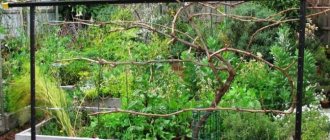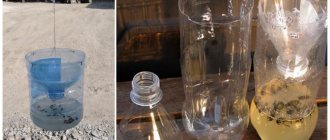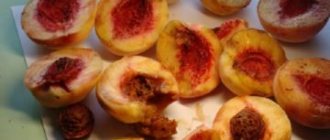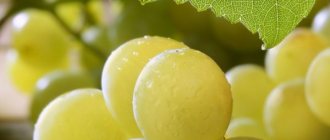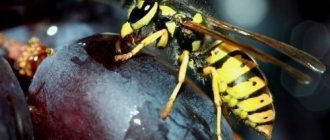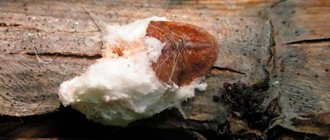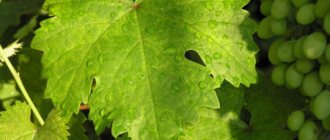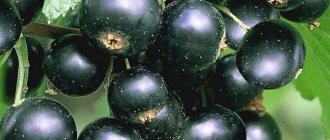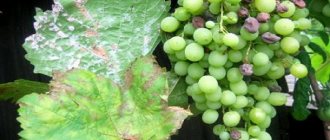Many people love table grapes - they are healthy, beautiful and tasty. It’s just that it gets boring picking out the bones. There is a solution - plant raisin grapes in the garden. Kishmish is the name given to grapes with underdeveloped seeds or completely devoid of them. Translated from Arabic, “quiche mish” means “dried grapes.” This is a natural mutation of ordinary grapes, selected and enhanced by man. The first varieties of sultanas appeared in Central Asia. Kishmish is grown for making raisins and as a dessert fruit. Juices and wines with good taste are also obtained from it.
Kishmish is the name given to grapes with underdeveloped seeds or completely devoid of them.
Kishmish grape varieties contain more sugars compared to regular ones. Being seedless makes sultanas a desirable delicacy; even small children can eat them.
Nutritional value
Dried grapes are tasty and nutritious, quickly making you feel full. 100 g of raisins contains:
- 8275 calories
- a quarter of the daily value of fiber - dietary fiber
- 762 mg potassium
- 0.3 mg copper
- 22 mg iron
In addition, sultanas contain folic acid, vitamins C, B12, and many other microelements. Grapes are useful for kidney and gastrointestinal diseases, osteoporosis, anemia, neuroses and depression. Has a choleretic effect. Potassium is essential for preventing heart disease. Diabetics should use sultanas with caution - they contain a lot of glucose. It is undesirable to eat raisin grapes during exacerbations of gastritis and stomach ulcers. It is useful during the recovery period. How to plant raisin grapes
Reproduction
The easiest way of propagation for me is rooting cuttings. How to store cuttings is indicated in a separate article; there is also a separate article on how to germinate them.
If your bush is already growing and you need 1-2 more, then the easiest way is to make layering. The method of propagation by layering is also discussed in a separate article.
Landing on time
Kishmish can be planted in both spring and autumn
Kishmish can be planted in both spring and autumn. Autumn planting is more often used in the southern regions. Usually planted in early October, when there is no threat of frost. For the winter, the seedlings are well insulated: a mound of soil is poured, and the top is covered with film or other protective material. In the northern viticulture zone, autumn weather is unreliable, so it is better to plant grapes in the spring. Dates vary from late April to late May. Dormant seedlings are planted before buds open, when the soil warms up to 10–12°C. Green seedlings rooted in containers can be planted in June.
Suitable region and climate
Kishmish has long left Central Asia - today this grape is grown in a wide variety of climates. There are varieties - early ripening and frost-resistant, which grow safely in regions with harsh winters and short summers.
But most of all, these grapes love sandy soils, rich in potassium and phosphorus, and light winds. Ideal conditions for growing sultanas are in Crimea.
The northern border of distribution stretches along the Kyiv-Saratov-Barnaul line. But it does not stop experienced gardeners - they manage to grow frost-resistant varieties of sultanas much further north.
Of course, sultanas in regions with frosty winters must be covered for the winter.
Kishmish grape planting technology
To plant a seedling, dig a hole 60-70 cm deep and wide, pour drainage - broken brick or coarse gravel - into the bottom. They dig in a support. Add a shovel of ash and a glass of superphosphate. Next, the hole is filled with a mixture of soil and humus. A deep hole is made for the seedling and planted at such a depth that there are 2 eyes remaining above the surface of the hole. The hole is spilled with warm water and the ground is mulched. In the first year, the shoots of the seedling are tied vertically to the support and only in subsequent years they are given an inclination according to the chosen shape.
How to care for sultanas
- Grape pruning. Most often, sultanas are cut off, leaving 8–12 eyes on the vine. Remove weak and unnecessary shoots. The load in clusters must be normalized. For each shoot, 1–2 large clusters are left, the rest are removed.
- In hot weather, abundant watering is required every 3-4 days. The amount of water depends on the soil, on average 2-3 buckets of water per bush. Two weeks before harvest, watering is halved to prevent cracking of the berries.
- Feeding is applied sparingly. In spring, nitrogen fertilizers, including organic ones, are appropriate. It is better to add liquid fertilizers when watering. By mid-summer, nitrogen fertilizing is stopped; phosphorus and potassium are needed for the ripening of vines and berries at this time.
- It has been noted that the stimulant gibberellin increases the size of berries and the density of sultana clusters. The drug “Ovary” is produced for summer residents. They spray grapes during flowering.
- Treatment against diseases and pests. Kishmish grapes need the prevention of fungal diseases. In spring and autumn, Bordeaux mixture or copper sulfate is used, in the summer - complex preparations Ridomil Gold, Strobi. Sometimes insecticides are used, for example, in the case of spider mites. During the ripening period, raisins are protected from wasps using special bags or fumigation with smoke.
Choosing a variety is an important matter. Over the long history of cultivation, various varieties of sultanas have been bred. Eastern Central Asian varieties are heat-loving; in most regions they do not ripen and freeze out. However, raisins have been bred that are suitable for cultivation in the regions of Russia.
Over the long history of cultivation, various varieties of sultanas have been bred
What varieties of sultanas are suitable for planting in the middle zone, the Ural and Siberian regions?
- Firstly, they are frost-resistant. There are varieties of sultanas with frost resistance down to – 23–28°C. Some varieties of Far Eastern and American selection can be grown as uncovered or as arbors. But in most cases, sultanas should be carefully covered in order to obtain a stable harvest.
- Secondly, sultanas that can ripen in the short northern summer. Kishmish varieties with a ripening period from very early to early-mid are suitable for growing in risky farming zones. In addition, ripening depends on the amount of positive temperatures during the growing season.
Description
Kishmish unites a group of varieties with similar botanical features and characteristics:
- Bunches. Dense or slightly loose. The berries are medium. The color of the fruit depends on the variety.
- Berries. With a dense structure, lightweight. Does not contain seeds. There are hybrid varieties in which the seeds are very small and undeveloped, and are practically not felt.
- Pulp. Very sweet, contains a lot of sugars - 18-25%. Kishmish is a grape ideal for the production of raisins. Sweet, seedless berries are what you need for this popular and valuable product.
Kishmish is a grape ideal for the production of raisins. Sweet, seedless berries are what you need for this popular and valuable product.
Rusbol (Kishmish Mirage)
Rusbol grapes ripen within 115–125 days
Ripens within 115–125 days. The clusters are conical, large, and can reach 1 kg. The berries are white, oval, pleasant taste, and there are rudiments of seeds. The fruitfulness of the shoots is high, so the vines can be cut short to 2-3 buds. Overloaded with harvest, requires rationing. The cuttings take root well. Frost resistance -25°C, moderately resistant to grape diseases. Rusbol is suitable for drying and as a table variety, its disadvantage is the presence of seeds. Recently, the analogue variety Rusbol improved (Elf) has become more common.
Diseases and pests
Productivity is lost due to diseases and pests. To prevent losses, timely prevention is needed.
Symptoms and measures to combat diseases and pests of Kishmish:
White rot
Initially, the ridge and stalk of the grapes are affected. Then the fungus spreads to individual berries, and then covers the entire bunch. The berries become lethargic, turn red and fall off.
Diseased vines become covered with round spots, edged with a black rim. In the affected areas, the bark is soaked. In damp weather, you can see the spores of the pathogen - dirty white dots.
They form on affected berries and areas of the vine. The problem most often appears after sunburn, hail, or mildew.
The disease is treatable; measures to combat it include spraying with a 4% solution of Bordeaux mixture, 5% Captan solution or 1% TMTD suspension.
Prevention:
- fulfillment of agricultural technology conditions;
- The pruning regime must be especially strictly observed so that the bushes are well ventilated and illuminated by the sun.
Gray rot
The disease can appear on berries at the very beginning of their formation. But the most affected are grapes that have begun to ripen or have already begun to ripen. The berries become covered with brown spots, the skin cracks on them, and a gray fluffy coating appears - sporulation of the fungus.
If the autumn is dry, then the fungus causes the berries to raisin, the so-called noble rot. Brushes affected by gray rot are not suitable for transportation and storage.
Unfortunately, there is no effective treatment for the fungus.
Therefore, all efforts should be directed towards preventive measures:
- timely breaking off and tying up shoots;
- thinning the leaf mass so that the berries have greater access to sunlight;
- At the first sign of damage, the entire crop should be immediately removed.
Rubella
The disease primarily affects the leaves. At the end of April - beginning of May, light spots appear on them, which then spread between the veins. On varieties with light berries, they become brown with a narrow waxy-yellow border.
On dark varieties, the color of the spots is bright burgundy with a yellow-green border. Affected leaves dry out and fall off prematurely. The consequence of rubella can be inhibition of the growth of shoots, inflorescences and ovaries.
The taste of the grapes may not change for the better.
If rubella appeared last season, then in the spring, as soon as the leaves begin to appear, spray 2–3 times with 1.5–2% Bordeaux mixture or 0.5% Zineb solution. The interval between procedures is 5 – 10 days.
Further treatment is the same as against mildew - 1% solution of Bordeaux mixture. Timely fertilizing and proper soil care will help reduce the risk of disease.
leaf roller
The leaf roller caterpillar damages buds, ovaries and berries. One caterpillar can destroy up to 50 buds. If the berries are damaged, then harmful microorganisms develop on them, leading to rotting, first of individual fruits, and then of the entire cluster.
For butterflies, baits are made in the form of containers hung among the bushes at a height of 70 cm from the soil surface.
Wine dregs, diluted 1/3 with water, are poured into the trap. Treatment with Vofatox (2.5 - 3 g of the drug per 1 m²) or Methylethylthiophos (15 g per 10 l of water) is used against caterpillars.
For the purpose of prevention, immediately after removing the winter shelter, you should peel off the old bark in which the pupae overwinter and burn it.
Wasps
These insects, attracted by the sweet taste of the berries, spoil their skin, making the grapes unable to be stored.
In addition, damaged berries undergo a rotting process, which extends to whole fruits. You can fight wasps in different ways.
This includes the use of pesticides, special traps and poisoned baits, and the destruction of nests. But if you consider wasps to be beneficial insects, then measures to combat them may not be so radical.
You can, for example, plant plants around the grape bushes whose smell is not to the taste of wasps - mint, lemon balm, basil. And in addition to this, put special protective bags made of tulle on the ripening bunches of grapes.
Kishmish Autumn Royal (Autumn Royal)
One of the largest-fruited seedless varieties. Kishmish was developed in the USA. Ripens late and is tested in the southern regions. The bushes are medium-sized. The clusters are large, weighing about 800 g. The berries are purple-black, weighing 6–8 g, thin-skinned. The taste is simple and harmonious. Resistant to frost down to -21°C, moderately resistant to diseases. The harvest is unstable. The quality of the berries depends on the load of the bush. Disadvantage - shedding of berries at the ripe stage. It is recommended to put covers on the bunches, which also protect the crop from wasps.
Origin story
The word "kishmish" comes from Persia. The literal translation is “dried grapes.” Central Asia is considered to be the birthplace of the variety, and the first mention of Kishmish is found in an ancient Uzbek fairy tale of the 13th century.
Kishmish, unlike other types of grapes, has very small seeds or none at all.
Such grapes owe their appearance to natural mutation. The winegrowers, noticing the results of natural “selection,” continued their experiments.
As a result, many varieties and varieties of Kishmish were obtained - white, pink, dark.
Einseth Seedlis
Seedless variety bred in the USA. Powerful tall bushes, can be grown on a gazebo. The variety is frost-resistant, like many descendants of “Isabella”. Ripens early. The clusters are small, 180–250 g, dense. The berries are pink or red, small. The skin is dense and can be removed with a “bag”. The pulp is juicy, with a characteristic strawberry “isabelle” aroma. Highly resistant to diseases. The berries are transportable, do not crack, and are suitable for eating and drying. Other popular varieties of American selection are Reliance Pink Seedlis, Red Flame, Neptune, Jupiter. Every gardener should plant a wonderful grape in his garden - sultanas!
How is Far Eastern lemongrass useful?
The beneficial and healing properties of the vine are due to its unique composition. The substances contained in the berries act on the body as a tonic and antioxidant, which in addition helps to strengthen its defenses. Vitamins and minerals. In lemongrass
high content of vitamins C and E.
Interesting materials:
How to prepare royal Pelargonium for winter? How to prepare red currant bushes for winter? How to prepare remontant raspberry bushes for winter? How to prepare honeysuckle bushes for winter? How to prepare lupine for winter? How to prepare young cherries for winter? How to prepare young blueberries for winter? How to prepare a greenhouse after winter? How to prepare the soil in a greenhouse for winter? How to prepare roses for winter at the dacha?
